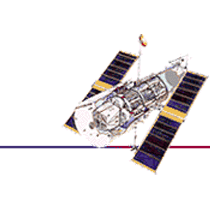Hubble Space Telescope
 The Hubble Space Telescope (HST) is a cooperative program of the European
Space Agency (ESA) and the National Aeronautics and Space Administration
(NASA) to operate a long-lived space-based observatory for the benefit of
the international astronomical community. HST is an observatory first
dreamt of in the 1940s, designed and built in the 1970s and 80s, and
operational only in the 1990s.
The Hubble Space Telescope (HST) is a cooperative program of the European
Space Agency (ESA) and the National Aeronautics and Space Administration
(NASA) to operate a long-lived space-based observatory for the benefit of
the international astronomical community. HST is an observatory first
dreamt of in the 1940s, designed and built in the 1970s and 80s, and
operational only in the 1990s.
Since its preliminary inception, HST was designed to be a different type of
mission for NASA--a long-term space-based observatory. To accomplish this
goal and protect the spacecraft against instrument and equipment failures,
NASA had always planned on regular servicing missions. Hubble has special
grapple fixtures, 76 handholds, and stabilized in all three axes. HST is a
2.4-meter reflecting telescope that was deployed in low-Earth orbit (600
kilometers) by the crew of the space shuttle Discovery (STS-31) on April
25, 1990.
HST's current complement of science instruments include three cameras, two
spectrographs, and fine guidance sensors (primarily used for astrometric
observations). Because of HST's location above the Earth's atmosphere,
these science instruments can produce high-resolution images of
astronomical objects. Ground-based telescopes can seldom provide resolution
better than 1.0 arc-seconds, except momentarily under the very best
observing conditions. HST's resolution is about 10 times better, or 0.1
arc-seconds.
Responsibility for conducting and coordinating the science operations of
the HST rests with the Space Telescope Science Institute (STScI) on the
Johns Hopkins University Homewood Campus in Baltimore, Maryland.
Partial List of Collaborators
Space Telescope Science Institute (STScI), The Johns Hopkins University,
USA; University of Washington, USA; University of California at Berkeley,
USA; University of Hawaii, USA; Vassar College, USA; Ohio State University,
USA; University of Arizona, USA; The University of Texas at Austin, USA;
Sterrewacht, Leiden University, The Netherlands; CEA-CEN Saclay, France;
Osservatorio Astronomico di Padova, Italy
Context of US/France collaboration: Search for absorption rays in spectra
from the Hubble Space Telescope, in the framework of the 'Absorption Line
Systems in Quasars' program.
http://www.stsci.edu/